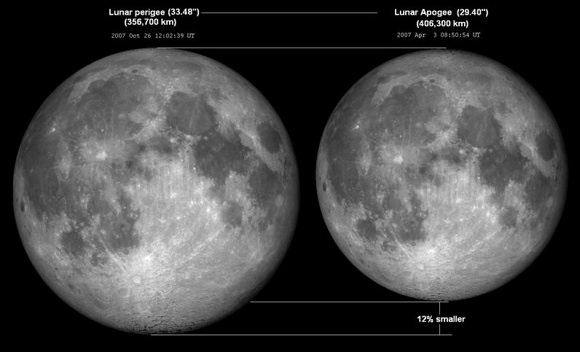
Photographs compare the view of a "Super Moon" versus the view of a "Mini-Moon."
The "Super Moon," on the left, occurred in April of 2007; the "Mini-Moon occurred in
2007 October. (Image Source: EarthSky.org )
By Glenn A. Walsh
Reporting for SpaceWatchtower
The Full Moon of March, on Thursday, is
the smallest Full Moon of 2015. This is due to the fact that the Moon
reaches the point of lunar apogee, in its orbit around the Earth,
just 10 hours earlier than the time of Full Moon.
Like the supposed “Super Moon,”
some people refer to a lunar apogee Full Moon as a “Mini-Moon,”
which is defined as a Full Moon occurring within 24 hours of lunar
apogee. In fact, this month's “Mini-Moon” is the closest lunar
apogee to a Full Moon until 2032 January 27 !
The March Full Moon occurs at 1:05 p.m.
Eastern Standard Time (EST) / 18:05 Coordinated Universal Time (UTC)
on Thursday, 2015 March 5. Lunar apogee, the farthest point the Moon
travels away from the Earth for this month (406,384 kilometers),
comes early Thursday Morning, 2015 March 5 at 2:36 a.m. EST / 7:36
UTC (the time of this blog post). Lunar apogees can range from
404,000 to 406,700 kilometers.
Consequently, at this time, sharp
viewers may notice that the Moon looks slightly smaller than how it
normally appears in the sky. The Moon will then be about 30,000 miles
farther away from the Earth than it would be during a lunar perigee Full
Moon, when the Full Moon is closest to the Earth in its orbit.
The Moon reaches its most distant point
from the Earth for 2015 on September 14 (406,464 kilometers); at that
time the Moon is near the New Moon phase. The Moon reaches its
closest point to Earth, during the Full Moon phase this year, at the
time of the Harvest Moon on September 28.
The rising outdoor temperatures, as the
days approach the Vernal Equinox, the official beginning of Spring on
March 20, leads to the thawing of the ground and the appearance of
earthworms, followed soon by robins. Hence, the Full Moon of March is
known as the Worm Moon.
However, Native Americans also had
other names for the March Full Moon. With the increased cawing of
crows, northern tribes knew the March Full Moon as the Crow Moon.
They also called it the Snow Crust Moon, for the increased crusting
of snow, caused by the thawing of snow by day and the freezing of the
water by night.
The Abenaki tribe (New England and
adjacent areas of Canada) called the March Full Moon “Mozokas” or
the Moose Hunter Moon. The Creek nation, located further south,
called it the “Tasahcusee” or Little Spring Moon. And, the Dakota
Sioux actually called it the “Moon When Eyes Are Sore From Bright
Snow.”
Colonial Americans called the March
Full Moon the Sap Moon, for the time when maple trees were tapped.
They also called it the Lenten Moon, as it was the last Full Moon of
Winter usually occurring during the Christian period of Lent.
Full Moon names for March, in the
Southern Hemisphere, include Harvest Moon and Corn Moon. However,
this year the March Full Moon is not the Harvest Moon in the
Southern Hemisphere. The Full Moon that will occur on April 4 will
actually be the 2015 Harvest Moon for the Southern Hemispere, as it
will be just slightly closer to the March 20 Vernal Equinox than this
month's Full Moon.
Link >>> http://earthsky.org/tonight/last-of-the-seasons-three-full-moons-on-march-5-2015
More on the Full Moon: Link >>> http://en.wikipedia.org/wiki/Full_moon
More on Full Moon names ---
Link 1 >>> http://earthsky.org/astronomy-essentials/full-moon-names
Link 2 >>> http://en.wikipedia.org/wiki/Full_moon#Harvest_and_Hunter.27s_moons
Link 3 >>> http://www.farmersalmanac.com/full-moon-names/
Source: Glenn A. Walsh Reporting for SpaceWatchtower, a project of Friends of the Zeiss.
Want to receive SpaceWatchtower blog posts in your inbox ?
Send request to < spacewatchtower@planetarium.cc >..
gaw
Glenn A. Walsh, Project Director,
Friends of the Zeiss < http://buhlplanetarium.tripod.com/fotz/ >
Electronic Mail - < gawalsh@planetarium.cc >
SpaceWatchtower Blog: < http://spacewatchtower.blogspot.com/ >
Also see: South Hills Backyard Astronomers Blog: < http://shbastronomers.blogspot.com/ >
Barnestormin: Writing, Essays, Pgh. News, & More: < http://www.barnestormin.blogspot.com/ >
About the SpaceWatchtower Editor / Author: < http://buhlplanetarium2.tripod.com/weblog/spacewatchtower/gaw/ >
SPACE & SCIENCE NEWS, ASTRONOMICAL CALENDAR:
< http://buhlplanetarium.tripod.
Twitter: < https://twitter.com/spacewatchtower >
Facebook: < http://www.facebook.com/pages/
Author of History Web Sites on the Internet --
* Buhl Planetarium, Pittsburgh:
< http://www.planetarium.
* Adler Planetarium, Chicago:
< http://adlerplanetarium.
* Astronomer, Educator, Optician John A. Brashear:
< http://johnbrashear.tripod.com >
* Andrew Carnegie & Carnegie Libraries:
< http://www.andrewcarnegie.
* Civil War Museum of Andrew Carnegie Free Library:
< http://garespypost.tripod.com >
* Duquesne Incline cable-car railway, Pittsburgh:
< http://inclinedplane.tripod.
* Public Transit:
< http://andrewcarnegie2.tripod.
No comments:
Post a Comment